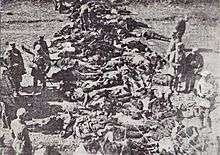Vyborg massacre
| Vyborg massacre | |
|---|---|
| Part of the Finnish Civil War | |
 Executed Russians at the Annenkrone fortification | |
| Location | Vyborg, Finland |
| Coordinates | 60°42′33″N 28°44′39″E / 60.7092°N 28.7442°ECoordinates: 60°42′33″N 28°44′39″E / 60.7092°N 28.7442°E |
| Date | 28 April 1918 – 3 May 1918 |
| Target | Russian men |
Attack type | Military assault, mass murder, genocide |
| Deaths | 360–420 |
| Perpetrators | White Guards |
The Vyborg massacre was the killing of 360–420 people in the town of Vyborg during the Finnish Civil War in April–May 1918. The massacre took place after the Battle of Vyborg as the White Guards captured the town from the Reds. Most of the victims were Russian civilians, mainly men and young boys.[1]
With 49,000 inhabitants, Vyborg was the second largest town in Finland. It was also the most diverse Finnish town, in 1910 Vyborg had the minorities of 5,000 Swedes and 3,200 Russians, as well as smaller groups of Germans, Jews and Islamic Tatars.[2] The White Guards' idea was to commit an ethnic cleansing of the Russian minority, the other ethnicities were killed as they were simply assumed as Russians.[1]
Victims
At least 360 of the victims were Russians, the rest being members of other ethnic groups living in Vyborg, including 23 Polish soldiers of the Imperial Russian Army, several Ukrainians, Estonians, Jews and Tatars, two Italians and one Baltic German. About one third of the murdered Russians were affiliated with the army. It is notable that they did not fight with the Reds, but were mostly unarmed. Only few of the victims had any connections with the Red Guards, most of them even supported the Whites and greeted them as liberators.[1]
The victims were of all social classes. Most of the killed Russian civilians were administrators working for the City of Vyborg, merchants, businessmen or handicraftsmen, also several noblemen were executed. The youngest victims were only 12–13-year-old schoolboys. Two of the murdered teenagers were the 13 and 15-year-old sons of Lieutenant Colonel Georgi Bulatsel who was one of the highest ranked Russian officers fighting for the Reds. He had been executed after the Battle of Tampere on 28 April.[1]
The massacre
The massacre started on 28 April during the Battle of Vyborg, escalating on the next day, after the Reds had either surrendered or fled the town. The largest mass executions were committed at the Annenkrone fortification on the western side of town and in the yard of Vyborg Castle, but mainly the killings took randomly place in the streets and yards. Some managed to survive as the Finnish or Swedish residents were hiding them.[1]
Executions were committed by the Vaasa and Kajaani regiments, which were parts of the Eastern Army of the White Guards, led by the General Major Ernst Löfström. Vaasa Regiment was led by the Swedish military adventurer Martin Ekström, who later became a leader of the Swedish Nazi organization National Socialist Bloc. Both regiments were composed of men who came from other parts of Finland but were in the Vyborg area. The local White Guards did not directly take part in the massacre. The mass killings were finally stopped on 3 May, by the declaration of the new town commandant G. A. Finne. Even after this, some Jägers intended to kill the whole Jewish population of Vyborg, but the plan was stopped by the local police chief K. N. Rantakari.[1]
Orders for conducting the executions were mainly given by the officers of the Jäger Movement. For example, the Jäger Major Harald Öhquist admitted that his company had shot some 150 "Red Ruskies", but did not mention who had given the order. After the war, General Karl Fredrik Wilkama was considered to be responsible for the massacre, but neither him nor anyone else was ever convicted or even charged in a court of law. Wilkama himself described the massacre as a "little accident".[1]
References
- 1 2 3 4 5 6 7 Westerlund, Lars: ”Me odotimme teitä vapauttajina ja te toitte kuolemaa – Viipurin valloituksen yhteydessä teloitetut venäläiset” p. 97–189. (in Finnish). Article in the book ”Venäläissurmat Suomessa 1914–22: Osa 2.2. Sotatapahtumat 1918–22”, Prime Minister's Office of Finland, 2004. ISBN 952-5354-45-8.
- ↑ Schweitzer, Robert: ”Saksalainen Viipuri” p. 22. (in Finnish). Article in the book ”Monikulttuurisuuden aika Viipurissa”, Viipurin Suomalainen Kirjallisuusseura, 2013. ISSN 1236-4304.